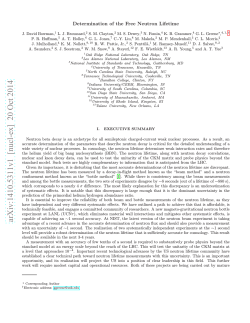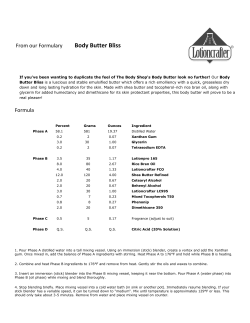
How to Detect Heavy Higgs Bosons of the MSSM Stefano Moretti
How to Detect Heavy Higgs Bosons of the MSSM (IFAE2007, Naples, 11-13 April 2007) Stefano Moretti NExT Institute (Southampton/Rutherford Appleton Laboratory) Outline of the talk • Supersymmetric (SUSY) Higgs spectra (masses and couplings) • Colliders phenomenology 1. Current limits from LEP, Tevatron 2. Future searches at LHC • Outlook MSSM • MSSM based upon: 1. minimal particle content; 2. Poincare invariance; 3. SM gauge invariance; 4. SUSY. • MSSM particle content: Gauge bosons S = 1 gluon, W ± , Z, γ Fermions S = 1/2 e uL νL dL eL uR , d R , e R Higgs 0 + H2 H1 H2− H10 Gauginos S = 1/2 f , Z, e γ gluino, W e Sfermions S = 0 e u eL νeL deL eeL u eR , deR , eeR Higgsinos 0 + e e H H 2 1 − e e0 H H 2 1 • Charged and neutral higgsinos mix with non-coloured gauginos to form physical mass eigenstates, so-called charginos χ e± e01,...4 . 1,2 neutralinos χ • Mixing also expected in b, t and τ sfermion sector. • Introduce additional discrete symmetry, R-parity: → forbid B − L violating interactions (i.e., no proton decay). • SM particles are R-even while SUSY ones are R-odd ! • MSSM with R-parity conservation: → SUSY in pairs and Lightest SUSY Particle (LSP) is stable (DM candidate). • Sparticles interactions fixed by gauge symmetries and SUSY: → no adjustable parameters, i.e. predictive ! • However, SUSY is non-exact symmetry of nature: → SM particle and SUSY sparticles non-degenerate masses ! • Mechanism of SUSY breaking not understood: L = L(SUSY) + L(SUSY-breaking). • (Soft-breaking terms terms are consistent with Poincare and SM gauge invariance) and do not reintroduce quadratic divergences for scalar particles !) • > 100 free parameters to parametrise SUSY breaking. • Models exist that assume universality of parameters at Plank/GUT scale (not treated here) • Two-doublet Higgs models are anomaly-free, e.g. MSSM. • SUSY structure also requires (at least) two Higgs doublets to generate masses for both “up”-type and “down”-type quarks and charged leptons. • MSSM Higgs sector consists of five physical Higgs particles: → two CP-even neutral Higgses, h0 and H 0 (Mh0 ≤ MH 0 ) → one CP-odd neutral Higgs boson, A0 → a charged Higgs boson pair, H ± . • AT LO, tan β (ratio of VEVs) and one Higgs mass (e.g., MA0 ) completely determine MSSM Higgs sector. • At LO: Mh0 < MZ , MA0 < MH 0 and MW < MH ± ! • Particle/Sparticle (virtual) effects enter in higher orders via 3GF Mt4 MS2 = √ log 1 + 2 . Mt 2π 2 sin2 β • When radiative corrections are included (NLO): Mh20 ≤ MZ2 cos2 2β + sin2 β . • NNLO (almost complete): → fig M h0 < ∼ 130 GeV ! (absolute MSSM upper limit) • Lightest Higgs mass (assume two scenarios): 1. Minimal mixing µ = At = Ab = 0 (dash); √ 2. Maximal mixing µ = 0, Ab = 0, At = 6MSUSY (solid). 160 Mh [GeV] a) 140 tgβ = 30 120 100 tgβ = 1.5 80 60 140 Mt [GeV] 160 180 200 220 • Mh0 very sensitive to top mass ! • What about heavy Higgses ? −→ next figure ! ! " # " $ $ " " # " $ $ " " " $ $ " $ " $ # # '& )( % " " MSSM Higgs collider searches • There exist limits from LEP2 and Tevatron, again assume: 1. Minimal mining scenario (i.e., no mixing in stop sector) 2. Maximal mixing scenario (i.e., t˜1 & t˜2 maximally mixed) • MSSM parameter space available is reducing ! • LHC prospects from ATLAS and CMS for the MSSM → no-lose theorem but large decoupling SM-like area ! • Ought to observe second Higgs state or make precision measurements of BRs, Γs, etc. • Ought to include interaction between Higgs/SUSY sectors: → Higgs → SUSY and SUSY → Higgs signatures ! LEP 88-209 GeV Preliminary mA° (GeV/c2) 160 140 No Mixing 120 Theoretically Inaccessible 100 80 60 40 Excluded by LEP 100 120 140 " # $% &' mh° (GeV/c2) ! 80 60 40 20 0 0 20 Ü LEP 88-209 GeV Preliminary mA° (GeV/c2) 200 180 mh°-max 160 ≥2σ Ü 140 120 100 80 ≥1σ 60 Theoretically Inaccessible 40 110 120 2 ! mh° (GeV/c ) 100 90 80 70 60 0 <1σ 20 Ü Br(H→τν) Ü 1 0.8 0.6 LEP 189-209 GeV 0.4 0.2 0 60 65 70 75 80 85 90 95 2 charged Higgs mass (GeV/c ) H ± at Tevatron (no updates on LEP’s results for neutrals) 2 . Mh20 + MW 200 180 # 160 % $ & • In the MSSM, MH ± = q 140 # $ % $ & 120 100 #$ ! " # # 60 $ $ % $ & 80 10 -1 1 10 10 The branching ratio for the decay t → bH + as a function of tan β for several values of MH ± and for mt = 178 GeV (left) and the tan β–MH ± parameter space excluded by the CDF and D0 collaborations from the non–observation of these decays (right). 2 LHC search channels for MSSM Higgses Typical discovery channels are: • h → γγ, inclusive production and production in association with an isolated lepton in W h0 and tth0 final states • h → bb in association with an isolated lepton and b-jets in W h0 and tth0 • A0 , H 0 → µµ, inclusive and in bbH 0 /A0 final states • A0 , H 0 → τ τ with 2`, ` + τ -jet and 2τ -jet final states • H ± → τ ν in gg → tbH ± and in qq 0 → H ± • H ± → tb in gg → tbH ± Note: • They only include SM-particle to Higgs interactions • This assumes no interaction between Higgs & sparticle sectors: i.e., SUSY mass scales all heavy (except Mχ˜01 and possibly mt˜1 ) CMS after 100 fb−1 of luminosity (MaxMix) ATLAS after 300 fb−1 of luminosity (MaxMix) tanβ 50 ATLAS -ATLAS 300 fb 40 -1 maximal mixing 30 0 0 0 + - h H AH 20 0 0 h H A 10 9 8 7 6 5 + - 0 h H 0 0 h only 4 0 3 LEP 2000 0 h H LEP excluded 2 0 0 0 + - 0 1 50 100 150 200 250 300 350 + - h H h H AH 400 450 500 m A (GeV) ATLAS after 300 fb−1 of luminosity (MaxMix) • Why do not reduce the SUSY mass spectrum ? To sub-TeV scales. • (Preferred scenario for SUSY couplings unification) Higgses → SUSY • Clean channel: A, H → χ02 χ02 → 4`± + ETmiss (χ02 → χ01 `+ `− , ` = e, µ) via Z (∗) or sleptons (F Moortgat et al., hep-ph/0112045 & hep-ph/0105081) CMS after 100 fb−1 assuming M1 = 90 GeV, M2 = 180 GeV, µ = 500 GeV, M`˜ = 250 GeV, Mq˜,˜g = 1000 GeV. • Can supplement with heavier -inos: A, H → χ ˜+ ˜− ˜0i χ ˜0j → 4`± + ETmiss aχ b ,χ (a, b = 1, 2, i, j = 1, 2, 3, 4) (M Bisset, N Kersting, F Moortgat, S Moretti, in progress) • Heavier -inos onset heavy Higgs decays M2 (GeV) 30 30 300 300 600 4050 1200 600 1200 1500 3885 1500 1800 12001500 300 600 3000 2400 3600 3600 3000 2400 180015001200 600 300 µ (GeV) Number of pp → H 0 , A0 → 4`N events, where ` = e± or µ± and N represents invisible final state particles, for 100 fb−1 , with tan β = 10 and MA = 500 GeV. Also shown is the percentage from H 0 , A0 → χ e02 χ e02 : > 90% (red), 50% – 90% (yellow), 10% – 50% (light blue), < 10% (white). Optimized slepton masses (with stau inputs raised 100 GeV) are used, mt = 175 GeV, mb = 4.25 GeV, mqe = 1 TeV, mge = 800 GeV, Aτ = A` = 0. The cross-hatch shaded areas are excluded by LEP. PRELIMINARY !!! χ ˜02 χ ˜02 dominated: M2 = 180 GeV, M1 = 90 GeV, µ = −500 GeV, m`esof t = mτesof t = 250 GeV AND NOT ATLAS !!! Heavier -inos dominated: M2 = 200 GeV, M1 = 100 GeV, µ = −200 GeV, m`esof t = 150 GeV, mτesof t = 250 (M Bisset, M Guchait, S Moretti, Eur.Phys.J.C19:143-154,2001; M Bisset, F Moortgat, S Moretti, Eur.Phys.J.C30:419-434,2003) Discovery Reach MSSM parameters: M2 = 210 GeV, P = 135 GeV, Msleptons = 110 GeV, Msquark, gluino = 1TeV Les Houches Workshop, May 2003 Filip Moortgat, University of Antwerpen SUSY → Higgses • Possible production & decay channels: pp → g˜g˜, q˜q˜, q˜q˜∗ , q˜g˜ → → 0 0 χ± 2 , χ3 , χ4 X 0 0 0 0 0 ± χ± X 1 , χ2 , χ1 h , H , A , H pp → g˜g˜, q˜q˜, q˜q˜∗ , q˜g˜ → → pp → 0 χ± 1 , χ2 X χ01 H ± , h0 , H 0 , A0 X t˜2 t˜∗2 , ˜b2˜b∗2 with t˜2 (˜b2 ) → t˜1 (˜b1 )h0 , H 0 , A0 or ˜b1 (t˜1 )H ± pp → g˜g˜, q˜q˜, q˜q˜∗ , q˜g˜ → t/t¯X → H ± X • Signatures: h0 , H 0 , A0 → b¯b and H ± → τ ν → hadronic in a multi-jet environment + ETmiss (A Datta, A Djouadi, M Guchait, F Moortgat, Nucl.Phys.B681:31-64,2004) CMS after 100 fb−1 assuming M2 = 175 GeV, M2 = 350 GeV, µ = 150 GeV, M`˜ = 175 GeV, Mq˜,˜g = 800 GeV Outlook • A no-lose theorem exists for MSSM Higgs bosons: we are guarantueed to find at least one state at the LHC • However, over a sizable region of the MSSM parameter space, this state (the lightest MSSM Higgs field) is degenerate with the SM field: we may not be able to distinguish a standard from a SUSY Higgs model at the LHC ! • These conclusions are however based on a decoupled MSSM, wherein SUSY objects are much heavier that the Higgs states (and SM matter) • This is no longer true if the mass scale of SUSY is low (≤ 1 TeV) • If Higgs-sparticle interactions are allowed, a rich phenomenology emerges • Under these conditions all MSSM Higgs bosons can potentially be observed (some rescaling of SM-like channels may be needed) • Approach so far: optmise yield of clean signatures implies discovery contours not overlayable (i.e., different MSSMs) on usual plane (MA , tan β) • Need to define SUSY Higgs benchmarks −→ figure (K Jacobs, S Moretti, P Osland et al., in progress) SUSY benchmarkpointsin mA tan E plane Require dedicated study to give suitable setofbenchmarkpoints 4 Snowmasspointsand slopes:SPS hep-ph/0202233 8 h, A, H, Hr h, A, H 7 9points:5+1mSugra,2 GSMB, 1AMSB h, Hr 1a h (SM -like) H, Hr h, H h, H, Hr h, A, H, Hr Chosen with SUSY space rather than Higgsspace in mind. h, Hr Only 4 pointsfeature in usual Higgs plane. 1a,4 (mSUGRA) 7, 8GMSB. Benchmarksfrom Carena etal. Eur. Phys. J. C 26 601(2003)notdes igned to take lightSUSY particle effects into account,exceptin stoploops (gluo-phobicHiggsscenario) Charged 2006 – Pheno & MC Summary 10
© Copyright 2025

![arXiv:1501.01596v1 [cond-mat.mtrl-sci] 3 Jan 2015](http://cdn1.abcdocz.com/store/data/000677901_1-c57a99574b8f8683aa5e14a1f057b4cc-250x500.png)



















